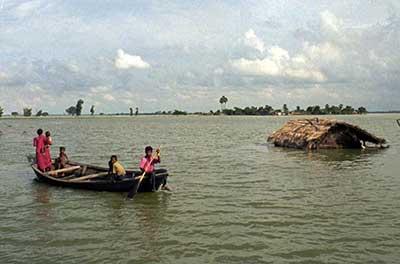Date: 08/05/2023
Relevance: GS-3: Climate Change, Global Warming, Atmospheric river and its effects; Disaster Management; Floods.
Key Phrases: Atmospheric rivers, Climate Change, Communications Earth and Environment journal, Developed Countries, Mitigation Efforts, Global Warming, summer monsoon season, Flood, Climate Challenge.
Context:
- According to a study published recently in the latest issue of
Communications Earth and Environment journal, around 70% of India’s major
flood events in the summer monsoon season were directly associated with
Atmospheric rivers (ARs) during the 1985–2020 period.
- The study was jointly conducted by climate scientists from the Indian Institute of Technology (IIT) Gandhinagar, the National Institute of Technology, Srinagar, and the University of Washington.
Key Highlights:
- To study the impact of ARs formed during the summer monsoon season on flooding in India, the research team used the high-resolution atmospheric fields from the European Reanalysis Version, along with observed precipitation from the India Meteorological Department and a historical flood database from the Dartmouth Flood Observatory of the University of Colorado (USA).
- According to the Dartmouth Flood Observatory data, during each year of the last decade, more than 3% of the total geographical area of India has been affected by floods.
- An Asian Development Bank report said that between 1990 and 2020 floods in India caused damage of over USD 50 bn.
Key Findings of Report:
- Seven out of the 10 floods with the highest mortality between
1985-2020 were associated with ARs.
- 2013 Uttarakhand floods, which claimed 6000 lives, the 2007 floods in South East Asia, including India, with 2000 human lives lost, the 1988 floods in Punjab, the 2018 floods in Kerala that claimed 400 lives, the 2006 floods in Gujarat, the 1993 floods in Assam, and the 2004 floods that caused extensive damage in Eastern India and Bangladesh were all due to severe ARs.
- These floods caused the loss of more than 9,000 human lives and several billion dollars worth of damages and displacements.
- The warming climate is increasing the moisture-holding capacity of atmospheric rivers, which leads to concerns about more devastating floods in the future.
- India experienced 596 major AR events from 1951 - 2020.
- More than 95% of these ARs occurred during the summer monsoon season, i.e., between June and September.
- Out of one-third of the top AR events, 54% occurred in the recent three decades, i.e, between 1991 and 2020, indicating a direct link between severe ARs and rising global temperatures.
- The frequency and severity of ARs show an increasing trend in
India in recent decades.
- Daily and sub-daily precipitation extremes have increased in recent decades and are likely to rise as the climate continues to warm.
- The report also considered extreme daily precipitation to have occurred when the rainfall for a particular day exceeded 1 mm of rainfall.
- The South Asian monsoon system is projected to transport more moisture under a warming climate, and that may lead to an increased frequency of ARs making landfall in India.
- Warmer sea surface temperatures over the south-central Indian Ocean play a crucial role in the development of ARs.
- Evaporation from the Indian Ocean has significantly increased in
recent decades due to an increase in Vapour Pressure Deficit (VPD).
- VPD is the measurement of pressure required to convert liquid to vapor.
- The frequency of ARs and floods caused by them has increased recently
as the climate has warmed.
- With the Indian Ocean warming up faster, there can be a considerable increase in evaporation, which could lead to more severe ARs.
- The effects of ARs varied considerably across India.
- The study found that the severity of ARs was greater in the lower Indo-Gangetic plains and peninsular India during the summer monsoon, while North India experienced ARs during July and August.
Atmospheric river
- About
- An atmospheric river (AR) is a narrow corridor or filament of
concentrated moisture in the atmosphere.
- In other words, it is a phenomenon of a stream of water vapor moving in the sky like a river flowing on land.
- It is also known as tropical plume, tropical connection, moisture plume, water vapor surge, and cloud band.
- Landfalling ARs during the summer monsoon has implications for water resources and deleterious flood hazards in India since they can deliver enormous amounts of precipitation within a few hours or days.
- The ARs are narrower and carry more moisture.
- The precipitation levels of these ARs are more in Western Ghats and Eastern Ghats regions, causing extreme rain events.
- An atmospheric river (AR) is a narrow corridor or filament of
concentrated moisture in the atmosphere.
Way Forward:
- This is the first time that the study was conducted to understand the
connection between ARs and flooding in India.
- More needs to be studied regarding the impact of global warming on ARs.
- With a warmer climate, flooding due to AR could only worsen in the coming years.
- Comprehensive monitoring of AR would also be necessary for early warning systems during the summer monsoon season in India to understand the possibility of extreme rain events and subsequent flooding.
- ARs should be an integral part of the existing flood early warning systems in India, which can help in adaptation and mitigation.
Conclusion:
- Floods have devastating impacts on the economy and society and understanding the role of ARs in the observed and projected future climate is crucial in mitigating the flood risks.
Source: The Hindu
Mains Question:
Q. What is the Atmospheric River AR? Also discuss the impacts of the atmospheric river on global climate. (150 Words).






















